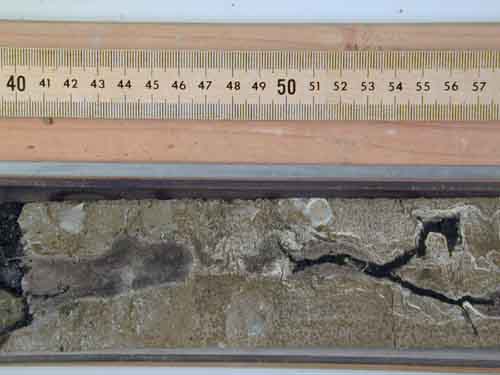|
Data & Samples > Core Samples > Gulf Coast Repository >
GCR Display Cores
Section 143-865A-89R-3

Location
Site 865 is located on the summit of Allison Guyot in the western Mid-Pacific
Mountains.
Site Objectives
This site was drilled for the following goals:
- Determining the timing of inception of the reefal complex;
- Documenting the history of subsidence and reef growth;
- Developing a picture of the facies anatomy of the reef and adjacent lagoonal environments;
- Identifying the timing and magnitude of relative sea level fluctuations;
- Constraining the timing and causes of the demise and drowning of the carbonate platform;
- Identifying and characterizing possible subareal exposure events;
- Developing a model of seismic stratification for comparison with other guyots; and
- Examining the post-drowning sedimentary history of the guyot summit.
Lithology
Clayey limestone and wackestone
Major lithology: Parallel too wavy laminated
clayey limestone, very dark grayish brown to light gray with peloids,
foraminifers, gastropods, bivalve fragments (mostly oyster), arthopods (rare)
and volcanic clasts. Slight to moderate bioturbation throughout the core.
Organic matter particles, oxydized pyrite and dolomite are common.
Minor lithologies: coal (in the form of a plant root), black, 37-70 cm
Age
Late Albian
Interpretation
The following discussion refers to Subunit IVC Sections 143-865A-80R-1 to 90R-5.
A lagoonal environment between a fringing reef and other form of barrier
and a central volcanic island is envisaged. Soil-derived material, including
smectite, was supplied from an extinct volcanic center. The climate was probably
humid, favoring terrestrial run-off and rich coastal vegetation.
At times, the lagoon was replaced by a marsh as
suggested by the root trace. Organic matter and pyrite-impregnated peloids,
fossils, and lithoclasts to form black pebbles. The presence of dolomite is
tentatively explained by seasonally evaporative conditions. Burrows were
preferentially dolomitized owing to their higher permeability. Episodic periods
of more normal marine conditions are suggested by the presence of glauconite and
orbitolinid foraminifers; and fuller, albeit transient, connections with the
open sea are indicated by the occurrences of planktonic species that were
perhaps washed into the lagoon.
| 
